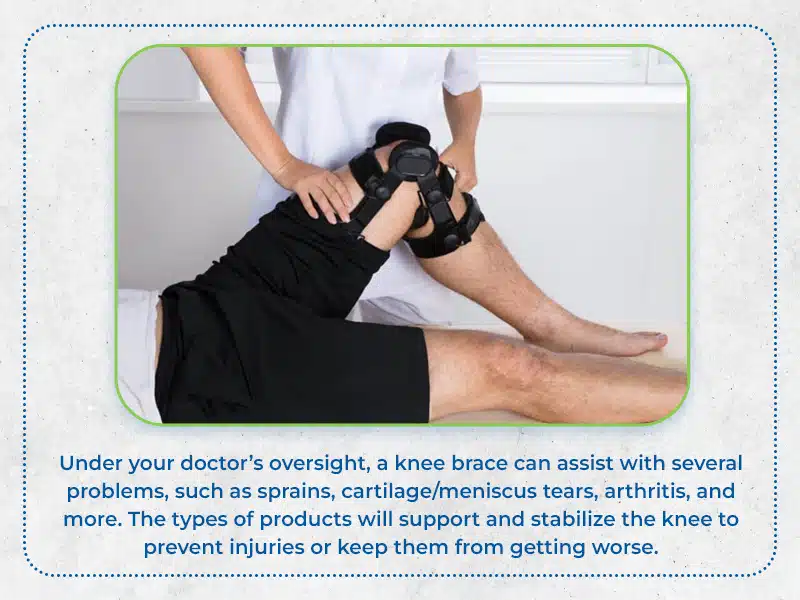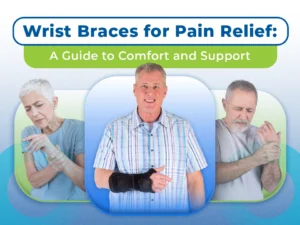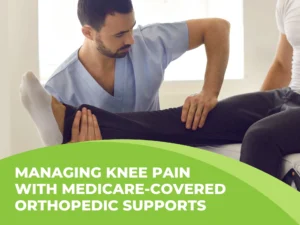Knee pain is a common complaint that can significantly impact daily activities and overall quality of life. Whether caused by injury, overuse, or underlying conditions, finding effective solutions to manage and alleviate knee pain is essential. In this comprehensive guide, we will explore various strategies, treatments, exercises, and the role of knee braces in providing relief and support for individuals dealing with knee pain.
Causes of Knee Pain
Knee pain can have various causes, ranging from acute injuries to chronic conditions. Common causes of knee pain include:
- Injuries: Sports-related injuries, falls, and accidents can lead to knee pain. These injuries may involve ligament sprains, meniscus tears, or fractures.
- Overuse: Repeated stress and strain on the knee joint, often seen in athletes or individuals who engage in high-impact activities, can result in overuse injuries and knee pain.
- Arthritis: Osteoarthritis, rheumatoid arthritis, and other forms of arthritis can cause knee pain due to joint inflammation and cartilage damage.
- Tendonitis: Inflammation of the tendons around the knee, such as patellar tendonitis, can cause pain and discomfort.
- Bursitis: Inflammation of the bursae, small fluid-filled sacs that cushion the knee joint, can lead to knee pain.
- Meniscus Tears: Tears in the meniscus, the rubbery cartilage that cushions the knee joint, can cause pain, swelling, and limited mobility.
- Ligament Sprains: Sprains of the anterior cruciate ligament (ACL), medial collateral ligament (MCL), or other knee ligaments can result in pain, instability, and difficulty with movement.
Common Knee Pain Conditions and Injuries
Understanding the specific knee pain conditions and injuries can help in determining appropriate treatment approaches. Some common knee pain conditions and injuries include:
- Patellofemoral Pain Syndrome: Also known as “runner’s knee,” this condition involves pain around or behind the kneecap.
- Osteoarthritis: The most common form of arthritis, osteoarthritis, is characterized by the gradual wearing down of the knee joint cartilage.
- Rheumatoid Arthritis: An autoimmune disease that causes inflammation and damage to the joints, including the knees.
- IT Band Syndrome: Inflammation of the iliotibial band, a thick band of tissue that runs from the hip to the knee, causing pain on the outer side of the knee.
- ACL Tears: Injuries to the anterior cruciate ligament, often occurring during sports or activities involving sudden stops or changes in direction.
- MCL Sprains: Sprains of the medial collateral ligament, commonly caused by direct impact or twisting motions.
Medical Treatments for Knee Pain
When experiencing knee pain, seeking medical attention for proper diagnosis and evaluation is essential. A healthcare professional, such as an orthopedic doctor or a sports medicine specialist, can assess your condition and recommend appropriate medical treatments. Some common medical treatments for knee pain include:

Knee Pain Solutions: A Comprehensive Guide to Medical Treatments.
1. Diagnosis and Evaluation
To determine the cause of knee pain, a healthcare professional may perform a physical examination, review your medical history, and ask about your symptoms. Diagnostic imaging tests, such as X-rays, magnetic resonance imaging (MRI), or ultrasound, can provide detailed information about the knee joint, helping identify issues like fractures, cartilage damage, or ligament tears. Laboratory tests, such as blood tests, may be conducted to rule out underlying medical conditions like arthritis.
2. Medications for Knee Pain Relief
Once the cause of knee pain is determined, medications may be prescribed to alleviate pain and reduce inflammation. Common medications used for knee pain relief include:
- Over-the-Counter Pain Relievers: Non-prescription pain relievers such as acetaminophen (Tylenol) or nonsteroidal anti-inflammatory drugs (NSAIDs) like ibuprofen (Advil, Motrin) or naproxen sodium (Aleve) can help reduce pain and inflammation in the knee joint.
- Topical Pain Relievers: Creams, gels, or patches containing analgesic or anti-inflammatory ingredients can be applied directly to the skin over the affected area to provide localized pain relief.
- Corticosteroid Injections: In some cases, corticosteroid injections may be administered directly into the knee joint to reduce inflammation and provide temporary pain relief. These injections are typically reserved for more severe cases and are performed by a healthcare professional.
3. Injections for Knee Pain
In addition to corticosteroid injections, other types of injections may be used to manage knee pain:
- Hyaluronic Acid Injections: Also known as viscosupplementation, hyaluronic acid injections inject a gel-like substance into the knee joint to provide lubrication and cushioning. This treatment is often used for knee osteoarthritis to help improve joint function and reduce pain.
- Platelet-Rich Plasma (PRP) Injections: PRP therapy involves using a concentrated solution of platelets derived from the patient’s own blood to promote healing and reduce inflammation. The platelets contain growth factors that can stimulate tissue regeneration in the knee joint.
- Regenerative Medicine Injections: Other regenerative medicine techniques, such as stem cell therapy, are being explored as potential treatments for knee pain. These therapies aim to harness the body’s natural healing processes to repair damaged tissues and reduce pain.
4. Surgical Options for Knee Pain Management
In cases where conservative treatments have not provided sufficient relief, surgical options may be considered. Some surgical procedures used to address knee pain include:
- Arthroscopy: This minimally invasive procedure involves inserting a small camera called an arthroscope into the knee joint to examine and treat various conditions. It can be used to repair ligaments, remove damaged cartilage or meniscus, or smooth rough surfaces.
- Partial Knee Replacement: In cases of localized damage, a partial knee replacement may be performed, where only the affected portion of the knee joint is replaced with an artificial implant.
- Total Knee Replacement: This procedure involves replacing the entire knee joint with an artificial joint made of metal and plastic components. It is typically recommended for severe cases of arthritis or extensive joint damage.
Read More: Coping with Chronic Knee Pain: Knee Braces for Older Adults
Non-Medical Approaches to Knee Pain Relief
While medical treatments are often necessary, non-medical approaches can also significantly manage knee pain. These approaches focus on self-care, lifestyle modifications, and complementary therapies. Some effective non-medical strategies for knee pain relief include:
- Rest and Ice Therapy: Resting the knee and applying ice packs can help reduce pain and inflammation. This is particularly useful after an acute injury or during flare-ups of chronic conditions.
- Physical Therapy and Rehabilitation: Physical therapy plays a vital role in knee pain management. A qualified physical therapist can design a personalized exercise program that includes strengthening exercises, range of motion exercises, and balance and proprioception training. These exercises help improve knee stability, flexibility, and overall function.
- Exercises to Strengthen the Knee: Targeted exercises for the muscles surrounding the knee joint, such as the quadriceps, hamstrings, calves, and hips, can strengthen the knee and provide stability and support.
- Weight Management: Maintaining a healthy weight is crucial for reducing stress on the knee joint. Excess body weight can increase pressure and strain on the knees, leading to pain and discomfort. Adopting a balanced diet and engaging in regular physical activity can help achieve and maintain a healthy weight, thereby relieving knee pain.
- Use of Assistive Devices: Assistive devices, such as canes, crutches, or walkers, can help alleviate pressure on the knee joint, particularly during periods of acute pain or recovery from injury or surgery.
The Role of Knee Braces in Managing Knee Pain

A man with knee pain is being assisted by a doctor.
Knee braces are valuable in managing knee pain and supporting the knee joint. Artik Medical Supply offers a range of knee braces designed to address various knee conditions and injuries. These braces provide stability, compression, and protection, helping to alleviate pain and promote healing. Some ways in which knee braces can assist in knee pain management include:
- Stabilization and Support: Knee braces, such as hinged knee braces, are designed to provide stability to the knee joint by limiting excessive movement and promoting proper alignment. They can be particularly beneficial for individuals with ligament sprains or tears, helping to prevent further injury and reduce pain.
- Compression and Swelling Reduction: Some knee braces offer compression around the knee joint, which can help reduce swelling and inflammation. This compression improves blood flow and promotes the removal of excess fluid, providing pain relief and aiding in the healing process.
- Protection and Injury Prevention: Knee braces, especially those with reinforced padding or patella stabilizers, can protect the knee during physical activities or sports. They help absorb impact, distribute forces, and reduce the risk of further injury.
- Post-Surgical Support: Following knee surgery, a knee brace may be recommended to provide post-operative support, limit movement, and protect the surgical site. It assists in maintaining the correct alignment of the joint during the healing process.
It is important to consult with a healthcare professional or orthopedic specialist to determine the most suitable knee brace for your specific condition and needs. They can provide guidance on the appropriate type of knee brace, the correct fit, and usage instructions for optimal results.
The Bottom Line
Knee pain can be debilitating, but with the right knowledge and strategies, it is possible to find relief and regain control over your life. By understanding the causes of knee pain, exploring medical and non-medical treatments, incorporating knee braces, and making lifestyle modifications, you can effectively manage knee pain and improve your overall well-being. Remember to consult with healthcare professionals to develop a personalized plan tailored to your specific needs. With perseverance and dedication, you can overcome knee pain and enjoy an active, pain-free lifestyle.
Our knee braces are universal in size and feature multiple range-of-motion positions to offer support and comfort to restore mobility. If you’re unsure what product is right for you or if you’re eligible for insurance coverage, Artik Medical Supply will provide the guidance you need. We can even communicate with your doctor to determine the best knee orthopedic brace for you. Contact us today to check for insurance coverage.
Article Tags
- Knee pain relief
- Knee pain management
- Knee pain treatment
- Knee pain prevention
- Knee pain remedies







